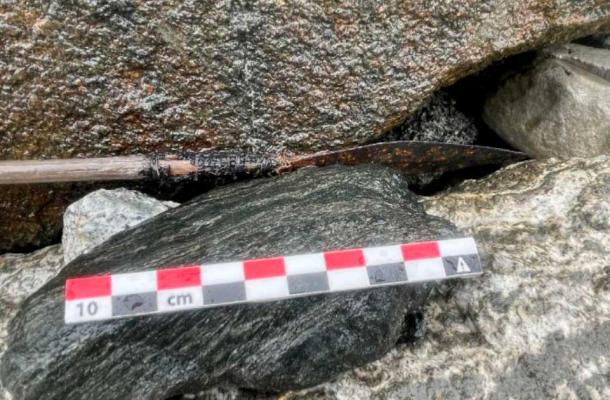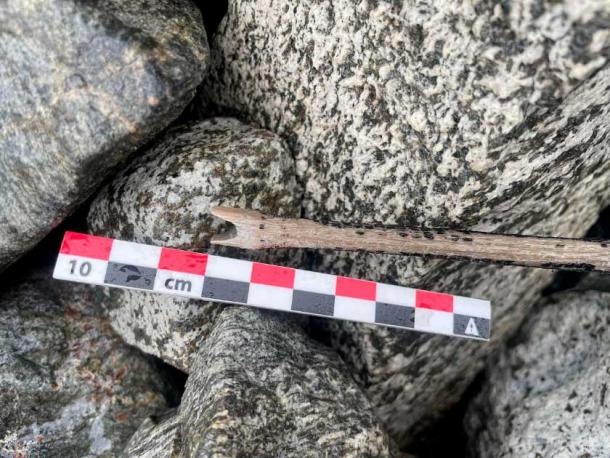1,300-Year-Old ‘Perfect’ Arrow Found in Norway Ice Patch
Norway’s Secrets of the Ice team have found a perfectly-preserved, ancient arrow in the Langfonne ice patch, which dates to the north European Iron Age period (500 BC-800 AD). Rapid melting and climate change are turning the Langfonne and Lendbreen ice patches, which are about 20 kilometers (12.4 miles) apart, into “treasure glaciers”. The latest ice patch arrow is exceptionally well preserved and will tell us more about life in this ancient northern pass used by Viking hunters and travelers from far away.
The year 2011 was known as the “The Great Melt.” And when temperatures soared across Europe, an ancient pass was revealed on Norway’s Langfonne ice patch in the Jotunheim mountains. This is not the first time Ancient Origins news has covered “treasure” artifacts found between the rocks of this ancient hunters’ traveler zone.
Over the last decade, Ancient Origins news reports have detailed several discoveries from the melting ice patches of Norway, including hundreds of pre-historic cairns, a 1,300 year-old-ski, a Roman sandal, and 68 arrows.
Earlier this year Live Science presented the discovery of a Stone Age arrow with a piece of feather fletching still attached. Incidentally, it is the fletching on an arrow shaft that provides spin, which in turn preserves arrow’s speed, flight stability, accuracy, and impact power.
Dr Lars Pilø, a cofounder of Secrets of the Ice, says it's “rare for arrow fletching to preserve,” as the delicate feathers that help guide the arrow in flight usually decay over time.
The latest ice patch arrow, a 1,300-year-old hunter’s arrow, found at this high-altitude archaeological site, holds evidence of lost craft skills from a bygone world.

The projectile end of the latest ice patch arrow lodged between stones on the lower edges of Norway’s Langfonne ice path. (Secrets of the Ice)
The 8th-century-AD Ice Patch Arrow and Summer Beast Hunters
Dr Pilø says that shortly after arriving at their base camp earlier this year, which is located at 1,750 meters (5,741 feet) above sea level, the team found the Norwegian Iron Age arrow on the lower edge of the icefield. It was discovered amidst broken rocks lodged between larger stones some “100 meters [328 feet]” from the edge of the glacier."
- Largest Ever Treasure Trove of Iron Age Weapons Retrieved in Oman
- Was It Just a Boss Spying on His Workers? First Viking Age Tower Found in Denmark
According to Arkeonews, Dr Pilø said this 1,300-year-old ice patch arrow was recovered from the “deepest core of the ice patch.” The archaeologist and project director think early hunters “had tracked creatures into the ice sheet that were avoiding being bitten by insects during the summer months.” And now, in 2022, this broken Iron Age arrow has “surfaced.”
Ancient Arrow Dynamics
The team believes the Iron Age arrow was initially lost by a hunter, and deposited downslope, where it was found, by meltwater. Over the last 1,300 years the projectile was probably exposed to the air several times at low ice melt levels. This was deduced because, unlike other arrows discovered at the site, the latest one had no fletching feathers at the notched end of the arrow, as the image below shows.
The Iron Age arrow was tapered towards the projectile end, and the nock (notch) in the fletched (feathered) end of the arrow was designed to receive a thick bowstring. The archaeologists also identified evidence of tar on the arrow, used to attach the fletching to the shaft. Furthermore, imprints of the threads securing the fletching are still visible. Together, these features are telling archaeologists more about the craft skills and technologies of these ancient Norse hunters.

The notched end of the recent ice patch arrow has no fletching feathers left, due to exposure, and was designed for a thick bow string. (Secrets of the Ice)
A Soon To Be Empty Ancient Treasure Chest
Most of the ancient arrows found at the Langfonne site date from the Late Neolithic and the Late Iron ages, which surface close to the present-day ice edge.
Many poorly-preserved artifacts have been found in front of the lower ice edge, while those in better states of preservation are more often identified along the sides of the glacier and above the upper ice edge.
- The Warrior Who Survived with an Arrow Embedded in His Spine
- Global Warming Reveals Amazing Glacier Artifacts from Switzerland’s Ancient Past
The northern archaeologists are getting somewhere mapping such discovery patterns, but in the not-too-distant future, the ice sheets will entirely vanish, and any remaining hunting devices will be blown away in the high-altitude winds.
The Secrets of the Ice website says the Langfonne ice patch is now “only 10% of the maximum extent of the ice during the Little Ice Age (AD 1450-1920).” Furthermore, it has retreated dramatically in the last two decades and is now “less than 30% of the size it was twenty years ago.”
This 70% glacial retreat means every year the team of researchers finds new patches of exposed bedrock free of moss and lichen. But within the next decade all this research will slow down as the winds do away with most remaining treasures.
Top image: A Secrets of the Ice team member proudly holding up the latest ice patch arrow released by Norway’s melting Langfonne ice patch.Source: Secrets of the Ice
By Ashley Cowie



















